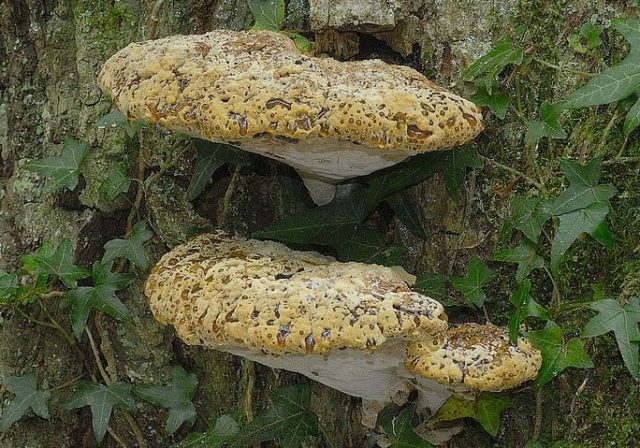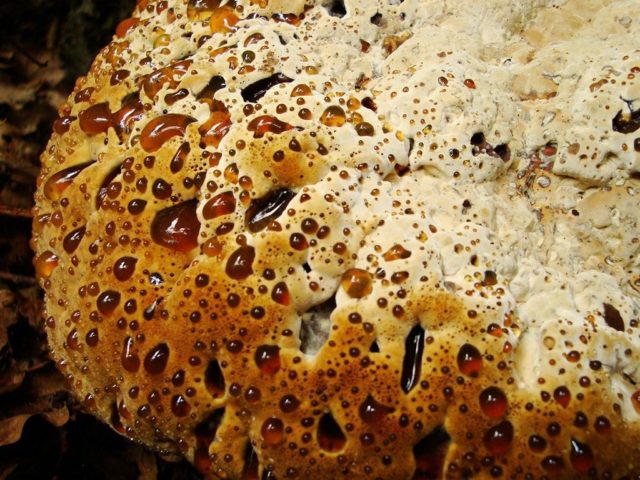Content
Polypore mushrooms are a group of the Basidiomycetes department. They are united by one common feature - growing on a tree trunk. Tinder fungus is a representative of this class, has several names: Oak tinder fungus, Pseudoinonotus dryadeus, Inonotus arboreal.
Description of the tree tinder fungus
The fruiting body of the basidiomycete is formed in the form of a large irregular sponge. The surface is velvety, covered with a layer of soft villi.
At high air humidity, the fruiting body of the tree tinder fungus becomes covered with yellow, small drops of liquid, similar to tree resin or amber.
The pulp is tough, woody, dotted with a network of shallow potholes. These are the pores through which the liquid from the pulp is discharged to the surface of the skin.
The fruit body is elongated, half, may be cushion-shaped. Its dimensions are among the largest: the length can be up to half a meter.
The oak tinder fungus encircles the trunk of the tree on which it grows in a semicircle. The height of the pulp is about 12 cm. The edge of the fruiting body is rounded, thickened and wavy, and the center is convex.
The skin of the basidiomycete is matte, the color is uniform, it can be mustard, light or dark yellow, red, rusty, olive or tobacco. The surface of the fruit body is uneven, bumpy, the reverse side is matte, velvety, white. Mature representatives of the species are covered with a rough crust or a thin, transparent layer of mycelium.
The hymenophore of the tree tinder fungus is tubular, brown-rusty. The length of the tubules does not exceed 2 cm; when dry, they become brittle. The spores are round, yellowish, with age, the shape of the tinder fungus changes to angular, the color darkens and turns brown. The spore envelope is thickened.
Where and how it grows
Inonotus arboreal grows in the European part of Russia, including the Crimea, in the Caucasus, in the Middle and Southern Urals. Rare specimens can be found in Chelyabinsk, in the region of Mount Veselaya and the village of Vilyai.
In the world, inonotus arboreal is widespread in North America. In Europe, in countries such as Germany, Poland, Serbia, the Baltic countries, Sweden and Finland, it is classified as a rare and endangered species. The decrease in its number is associated with the felling of old, mature, deciduous forests.
This is a wood-destroying species, its mycelium is located at the root collar of an oak, on the roots, less often on the trunk. While developing, the fruiting body provokes white rot, which destroys the tree.

Sometimes a spongy fruiting body can be found on maple, beech or elm.
Tinder fungus develops singly, rarely several specimens are attached to the tree trunk side by side in a tile-like manner.
Inonotus arboreal grows very quickly, but around July or August, its fruit body is completely destroyed by insects. The mycelium does not bear fruit every year; it affects only oppressed, diseased trees growing in unfavorable conditions. As soon as the oak tinder fungus settles at the foot of the tree, the culture begins to wither, gives a weak growth, breaks down even from weak gusts of wind.
Is the mushroom edible or not
The oak tree representative of the tinder fungus (Pseudoinonotus dryadeus) is not an edible species. It is not eaten in any form.
Doubles and their differences
The appearance of the fungus is bright and unusual, it is difficult to confuse it with other Basidiomycetes. No specimens similar to it have been found. Even other representatives of tinder fungi have a less bright color, rounded shape and bumpy surface.
Conclusion
Tinder fungus is a parasitic species that primarily affects the root of the plant. The mushroom cannot be confused with others, thanks to its bright yellow color and amber drops on its surface. They do not eat it.









